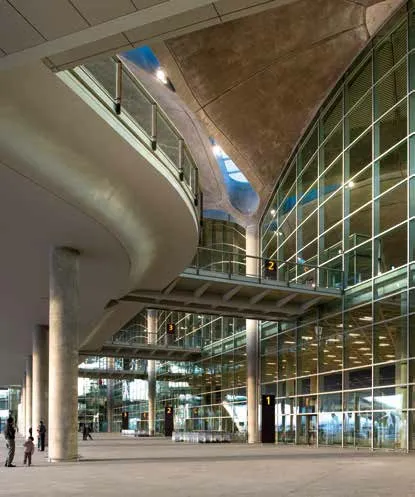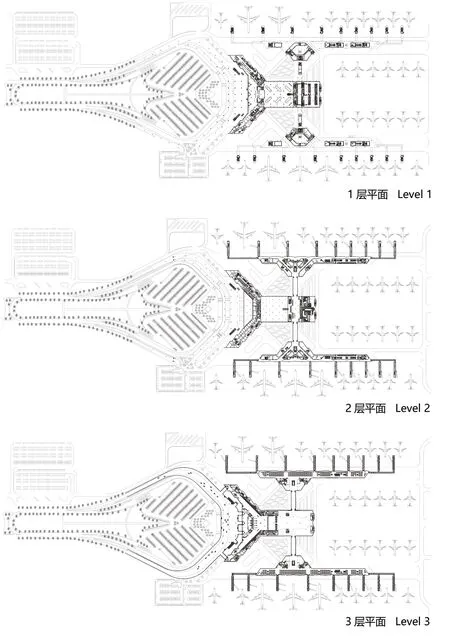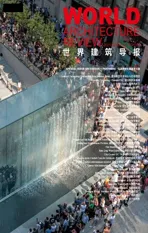阿勒娅女王国际机场
2021-05-11NigelYoung
业主单位:约旦哈希姆王国交通部
项目地点:约旦安曼
建筑设计:福斯特建筑事务所
结构设计:Buro Happold
面积:一期竣工100 000 平方米;二期竣工116 000 平方米;剩余面积约60 000 平方米
设计/建造:2005 / 2014 年
摄影:Nigel Young / 福斯特建筑事务所
Client: The Hashemite Kingdom of Jordan Ministry of Transport
Location: Amman, Jordan
Architectural Design: Foster + Partners
Structural Engineer: Buro Happold
Area: 100 000 m2by completion of Phase 1; 116 000 m2completion of Phase 2 Existing terminal area is around 60 000 m2
Design / Completion: 2005 / 2014
Photography: Nigel Young / Foster + Partners
机场设计受到地方传统的启发,采取了一种被动式设计手法,并基于灵活的模块化解决方案,以此来保证未来机场的扩张——新机场作为黎凡特地区的主要城市枢纽,将保障该地区在未来25 年内年增长率6%的速度,至2030 年,地区人口将从350 万增长至1200 万。
鉴于安曼地区的气候特征——夏季昼夜温差极大,机场主要采用了混凝土的被动式环境调控材料。棋盘格式的屋顶包含了一系列的浅混凝土穹顶,能够拓展进行遮阳,每个圆顶同时是一个模块化的施工单元。整个圆顶顺次排列开来,就像沙漠里的棕榈树树叶,日光在叶子之间汇合,那里同时也是机场的梁架支柱。每个树叶的纹理和几何模式,都与伊斯兰传统形式相呼应。整个复杂的屋顶结构和制作策略由福斯特建筑事务所的几何专家设计完成。
登机口位于中央大楼的两侧,中央大楼主要包含手续办理区域、商店、休息室和餐厅。在这些区域,与该地区乡土建筑相协调的露天庭院是设计中的一个重要环境策略:通过植物和树木来净化空间,同时间接的将自然光引入机场内部。
航站楼能够提供面朝停机坪的各个方向视野。水平的百叶窗能够遮挡外部的直射阳光和消除炫光,百叶窗在暴露区域更加紧密的排列。混凝土结构结合了当地的砾石,能够减少维护需求和节约材料能源,并与自然砂石的色彩更加融合。
安曼是世界上最早有人居历史的城市之一——机场设计特别注意了与当地历史、建筑特色的呼应,尤其是穹顶,从空中来看,就像是黑贝都因人的流动帐篷。这也与约旦好客的传统相匹配——为了庆祝家族团聚,而会在机场前广场聚会,目前机场前广场已经被拓展为一个优美的城市广场,包含了树木掩映下的座椅,这也在送别亲人和迎接亲人时,都可以在这里相聚。
Queen Alia International Airport continues the practice’s explorations of the airport terminalas a building type and sets out a vision for an environmentally sensitive, regionally apt,airport architecture. Designed to serve as the main gateway to Amman - one of the oldestcontinually inhabited cities in the world - its design resonates with a sense of place andlocal culture.Strategically the building secures Amman’s position as the main hub for theLevant Region.Logistically, it allows the airport to grow by 6 per cent per annum for thenext twenty-five years,increasing capacity from 3 million to 12 million passengers perannum by 2030.
In response to local building expertise and Amman’s climate, where summer temperaturesvary markedly between daytime and night time the building is constructed entirely fromconcrete, the high thermal mass of the material providing passive environmental control.The tessellated roof canopy comprises a series of shallow concrete domes, which extendto shade the facades. To enable seamless future expansion, each dome is a modular unit.
The domes branch out from the supporting columns like the leaves of a desert palm anddaylight floods the concourse through split beams at the column junctions. Echoing theveins of a leaf, a geometric pattern based on traditional Islamic forms is applied to eachexposed soffit.
The terminal is glazed on all sides to open up long views to the aircraft on the apron andaid orientation. Two piers of departure gates run along either side of the central building,which contains the main processing areas and shops, lounges and restaurants. Betweenthese volumes, open-air courtyards draw on vernacular Arabic architecture and contributeto the terminal’s environmental strategy: the plants and trees help to filter pollution andpre-condition the air before it is drawn into the air handling system. In celebration of thetradition for family groups to congregate at the airport, the forecourt has been enlarged tocreate a landscaped plaza with seating, shaded by trees, where people can gather to bidfarewell or welcome returning travellers.
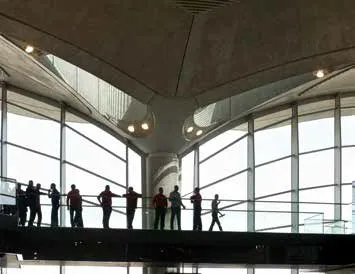
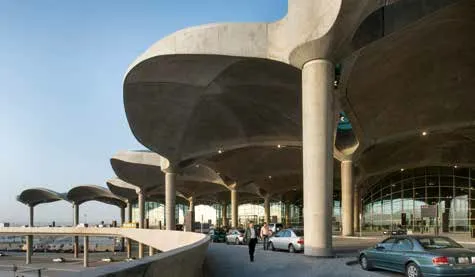


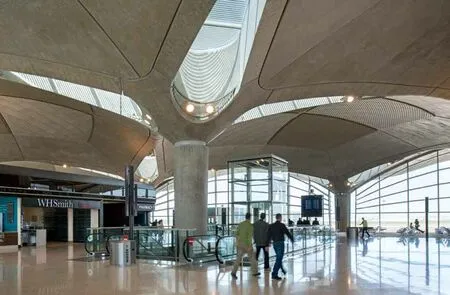

剖面 Section
